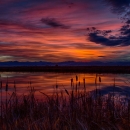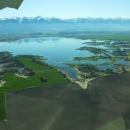About Us
The rolling terrain and interspersed small wetlands of the Mission Valley were created by pre-historic glacial activity which ended approximately 12,000 years ago. These wetlands are called kettles and were formed from melting glacial ice and are of enormous value to many wildlife species. Within this rich and productive environment, the Refuge provides unique benefits to wildlife by being among the few places in the valley where wildlife protection and conservation are the driving priorities.
Water Resources
The reservoir at the core of Pablo National Wildlife Refuge contains about 1,850 surface acres at full pool level. The only Service influence of water levels comes through cooperation with the Flathead Irrigation Project. In the case of conflicts, wildlife becomes secondary to irrigation needs due to wording in the 1921 Executive Order. However, the water regime for irrigation has generally benefited wildlife at Pablo National Wildlife Refuge. In particular, the refuge has become an important area for the reintroduction of Trumpeter swans as well as a breeding and staging area for a large portion of the Flathead Valley Canada goose population. The Refuge also supports a variety of ducks and numerous species of other marsh and water birds.
Visual Resources
The unique geological history of this area has created areas of sharp relief and contrast resulting in 10,000 foot mountain peaks which rise up from the valley floor in a 7,500 foot abrupt wall. These mountains, with their snowy peaks, create a backdrop of extraordinary beauty for the wetlands of Pablo National Wildlife Refuge. The Refuge offers a magnificent visual diversity as well as a diversity of habitats and wildlife.
Our Mission
Northwest Montana Wetland Management District Vision
Relax and take a deep breath while you step back in time to reflect on what was, what is, and what is yet to come. Immerse yourself in the inter-montane valleys of northwestern Montana shaped by glacial forces and steeped in rich cultural history. This is a special landscape important to people age after age, where we pay tribute to the persons and peoples who set aside the lands, conserved the wildlife and plants, and were stewards of various components that make up the Complex. Visitors from all over the world travel to the Complex, which seeks to provide an opportunity to learn and experience varied habitats, abundant wildlife, and the natural beauty of these lands. The units of the Complex safeguard these values and preserve connectivity across the landscape, forming continuity through time for future generations to treasure. Each unit is unique, and collectively they have contributed, and will continue to contribute, to the Complex and the Refuge System. Partners foster cultural and natural resources conservation where the cultural history is expressed across the landscape. Unique opportunities to work with partners benefit many of the units within the Flathead Indian Reservation and other units located within traditional homelands of the Séliš, Qĺispé and Ksanka Tribes.
Our History
Lands within the Pablo Refuge boundary were first withdrawn in 1910 for an irrigation reservoir as part of the Flathead Irrigation Project. Executive Order 3504 established the Refuge on this withdrawal in 1921, subject to reservoir uses. The Confederated Salish and Kootenai Tribes (CSKT) requested the establishment of Pablo National Wildlife Refuge and the refuge is located on Trust lands of the CSKT. A 1948 Act of Congress reimbursed the CSKT $400,000 for all past and future uses of certain reservation lands for physical works and facilities of the Flathead Project irrigation and power systems, and for Pablo and Ninepipe National Wildlife Refuge. The payment included $68,712 for the permanent easement at Pablo National Wildlife Refuge.
The 1948 Act also stated that the Tribes "shall have the right to use such Tribal lands, and to grant leases or concessions thereon, for any and all uses not inconsistent with such permanent easement.” The Service has had positive influence on management of the refuge for wildlife purposes. The Tribes manage the fishery resources in the Pablo Reservoir.
The reservoir contains about 1,850 surface acres at full pool level. The only Service influence of water levels comes through cooperation with the Flathead Irrigation Project. In the case of conflicts, wildlife becomes secondary to irrigation needs due to wording in the 1921 Executive Order. However, the water regime for irrigation has generally benefitted wildlife at Pablo National Wildlife Refuge. In particular, the refuge has become an important area for the reintroduction of trumpeter swans to the Mission Valley.
Other Facilities in this Complex
Pablo National Wildlife Refuge is managed by the Northwest Montana Wetland Management District as part of the Western Montana National Wildlife Refuge Complex. A Complex is an administrative grouping of two or more refuges, wildlife management areas, or other refuge conservation areas that are managed from a central location. Refuges are grouped into complexes because they occur in a similar ecological region, such as a watershed or specific habitat type, and have a related purpose and management needs.
For the Western Montana National Wildlife Refuge Complex, the project leader is stationed at Benton Lake National Wildlife Refuge and oversees general management of the Complex. Refuge managers oversee the operations at specific refuges. Supporting staff, composed of administrative, law enforcement, refuge manager, biological, fire, visitor services, and maintenance professionals support all refuges within the complex.
The District headquarters is located near Ronan, MT, 59864. The phone number is 406-750-8242.
The Complex headquarters is located at Benton Lake National Wildlife Refuge, 922 Bootlegger Trail, Great Falls MT 59404.
The refuges in the Western Montana National Wildlife Refuge Complex include:


